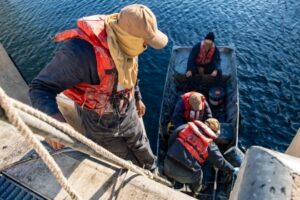
Late last year, sailors board a lifeboat to provide maintenance on the Nimitz-class aircraft carrier USS Harry S. Truman (CVN 75). The carrier was undergoing a planned incremental availability (PIA) at Norfolk Naval Shipyard. (.S. Navy photo by Mass Communication Specialist 3rd Class Charles Blaine
WASHINGTON, DC — The Navy has been under public scrutiny in recent years after experiencing a rash of suicides aboard multiple ships, many of them undergoing maintenance at shipyards.
Earlier this year, the Pentagon’s Inspector General announced that it would be opening an investigation into the Navy’s response to suicides by active-duty sailors. According to a memo sent to the secretary of the Navy, the purpose of the investigation is to determine whether the Navy “effectively took actions to prevent and respond to incidents of deaths by suicide, suicide attempts, and suicidal ideation.”
For example, in April 2021, three sailors aboard the U.S.S. George Washington died by suicide within one week of each other. A fourth sailor stationed on the aircraft carrier died by suicide earlier that December, with a total of nine sailors on the ship dying by suicide since 2019.
At the time, the ship was undergoing extensive maintenance at a shipyard in Newport News, VA, and living conditions for the sailors aboard were reported to be particularly difficult. A Navy investigation found the deaths were not related, though it did highlight deficiencies in the Navy’s mental health services.
The investigators noted that statistics show sailors aboard a nuclear-powered aircraft carrier like the George Washington that are stationed in a shipyard are more than twice as likely to die by suicide compared to when the ship is at sea. When reduced crew size during maintenance is factored into the equation, that rate increases to three times. However, according to the Navy’s report, “resourcing of mental health providers does not reflect this elevated risk.”
That increased likelihood is due, at least in part, to underresourced shipyards, Navy leaders noted. “[The Newport News Shipyard] is insufficient to support the crews of multiple aircraft carriers and submarines in overhaul and new construction in the shipyard,” the report stated. “There remains inadequate parking, transportation, access to food and nutritional options, training space, physical fitness facilities, and housing options available to support the number of sailors assigned to ships and submarines in the shipyard. This directly contributed to poor sailor quality of service and morale.”
This is exacerbated by a lack of incentive for maintenance on ships to be completed in a timely fashion, resulting in a backup at the shipyard that leaves some sailors stationed there for years. This backup results in more sailors competing for limited resources and further diminishes quality of service.
Suicide Clusters
The suicides aboard the George Washington were just one of a number of suicide clusters among sailors in recent years, according to the report. In late 2022 and early 2023, three sailors stationed to the U.S.S. Roosevelt died by suicide. Of those, the death of Electricians Mate (Nuclear) 3rd Class Jacob Slocum received the most attention from both the press and Navy investigators, as there was abundant evidence that he had been struggling.
A Navy investigation found that Slocum had fallen behind in his qualifications and had been sent to a captain’s mast to be disciplined. He expressed that he did not want to remain in the service but had been told to keep trying to qualify. The investigation found that some supervisors were especially hard on Slocum and contributed to a toxic work environment for the entire nuclear department. Friends of Slocum noticed signs of depression and suicidal ideation, but word was never passed on to supervisors.
The investigation also found that the Roosevelt was significantly underresourced when it came to mental health providers, resulting in many servicemembers receiving off-the-books outpatient care. In the months prior to Slocum’s death, two-dozen crewmembers had separated from the Navy, and another 14 had been placed on limited duty.
The deaths aboard the George Washington were startling enough to draw the attention of legislators, who included a provision in the FY2023 National Defense Authorization Act directing the Pentagon Inspector General to conduct its investigation into the Navy’s suicide prevention efforts. According to the Pentagon, the investigation will include site inspections at Norfolk, VA; Naval Base San Diego; Naval Base Kitsap Bremerton in Washington; and Naval Station Pearl Harbor in Hawaii.

